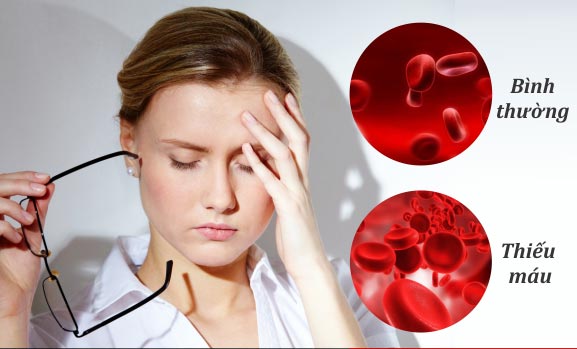News - Tue, 12/29/2020 - 11:34
Iron-deficiency anemia
Last update 09/27/2024 - 17:58

What is the role of iron in the body?
Iron is very important in maintaining many physiological functions of the body, especially in oxygen transport. It is a component of hemoglobin which is contained in red blood cells produced in bone marrow. Hemoglobin contains about 70% of the body's iron, 20% of body iron is in muscular cells, particularly in myoglobine.
In blood, iron is attached to a transporting protein: transferrine or sidérophiline and it is the later that will distribute iron in cells.
Unused iron will be stored in a form attached to the ferritin. The major sites of iron storage are the liver and macrophages. This volume will be used when the body’s need for iron increases such as in growing children, pregnant or breastfeeding women.
Because iron plays a crucial role in the production of red blood cells, any abnormal metabolism of iron can result in iron-deficiency anemia (anemia means that hemoglobin level is lower than normal. The normal hemoglobin level is 13g/dl in men, 12g/dl in women and 11g/dl in pregnant women).
Where does iron come from?
- Foods
- Red blood cell metabolism
Iron from foods must be absorbed by the body. The absorption of iron from this source occurs in small intestine, most takes place in duodenum.
What are the causes of iron deficiency?
There must be a balance between iron supply and demand in healthy people. This balance may be broken due to several reasons: inadequate iron supply, decreased absorption of iron, increased iron loss, increased iron demand (growth, pregnancy).
Iron loss are due to :
- Physiological iron loss: stools, desquamations of cells, woman’s periods.
- May or may not associated to pathologic iron loss: bleeding for example gastrointestinal (GI) or gynecological bleedings.
Iron deficiency can be identified through blood tests measuring iron metabolism markers.
What are the clinical symptoms of anemia?
Anemia may have different symptoms which can be fatigue, out of breath, pale, dizzy, palpitations, hair loss, etc.
Hemoglobin test is the only way to check for this condition.
What is the treatment for a mild iron deficiency?
In case of mild iron deficiency, your doctor will prescribe oral iron supplements for 3 to 6 months. The cause of anemia must be corrected for example by stopping a bleeding.
How much iron do we need a day?
Iron demand changes upon ages, gender, pregnant or breastfeeding women.
(Tec & Doc Lavoisier 2000)
|
Age range |
Recommended intakes for iron (mg/day) |
|
|
New born |
7 |
|
|
Children |
1-9 years old |
7 |
|
10-12 years old |
8 |
|
|
Teenagers (13-19 years old) |
Boy |
12 |
|
Girl |
14 |
|
|
Adults |
Males |
9 |
|
During the period |
16 |
|
|
Pregnant |
25 - 35 |
|
|
Breastfeeding |
20 |
|
|
Menopausal |
9 |
|
Which foods are rich in iron?
Foods that are rich in iron include liver, black pudding and red meat. Only a fraction of the iron contained in the foods that we eat is absorbed by our body. It depends upon its biodisponibility. Iron can be classified as:
- Haem iron, found in hemoglobin and myoglobine of animal products. Haem iron is absorbed at high rate (of from 20 to 30%).
- Non-haem iron – found in cereals, dried beans, fruits, vegetables and milk products. Absorption of non-haem iron is changeable and dependent on the composition of the meal. Some factors stimulate or inhibit the absorption of this kind of iron. The rate of absorption may range from 1 to 20% influenced by mechanism of these factors. Meat, fish, ascorbic acid (vitamin C) help your body absorb nonhem iron better. On the contrary, polyphenols, tannins, phytates, some protein forms and fibre containing foods decrease iron absorption. Tea and coffee are inhibitors of non-haem iron absorption.
Therefore, the composition of the meal influences the rate of iron absorption, from 5% (meals with cereals, few meat products and few vitamin C) to 15% (meals with meat products and vitamin C).
Ciqual, Tec & Doc Lavoisier 2000
|
Foods |
Iron value mg/100 g |
|
Animal foods |
|
|
Black pudding |
20-22 |
|
Livers of cattle and sheep |
10-15 |
|
Fatty liver, egg yolk |
4-8 |
|
Sheep, cow, horse, duck, white goose |
2-4 |
|
Fish, seafood, boiled egg, goose, veal, meat, ham |
1-2 |
|
Plant foods |
|
|
Wheat germ, peach pip, soybean |
6-10 |
|
Lentil, peas, dried bean, spinach |
2-4 |
|
Bread, green bean, |
1-2 |
For further information, please contact us at: (84-24) 3577 1100, or send us an inquiry here or make an appointment here.



